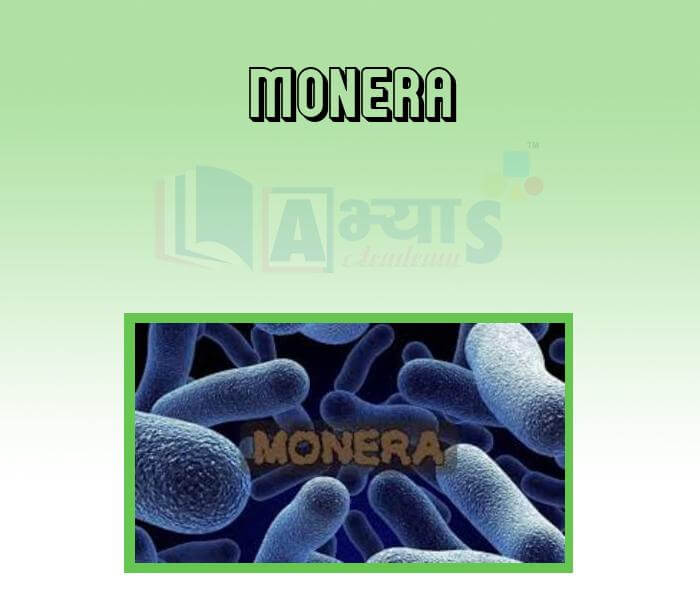Monera


Monera
This kingdom comprises of single-celled prokaryotic bacteria, filamentous actinomycetes and photosynthetic blue-green algae (cyanobacteria). Carl Woese (1977) divided Monera into Archaebacteria (primitive bacteria) and Eubacteria (true bacteria).
Bacteria: Bacteria are unicellular and generally occur singly. Some of them are found in groups. They are named according to their shapes.
1. Rod-shaped bacteria are called bacilli (singular: bacillus), e.g., Bacillus anthracis, which causes the disease anthrax.
2. Spherical bacteria are called cocci (singular: coccus), e.g., Streptococcus pneumoniae, which causes the disease pneumonia.
3. Other types are spiral bacteria called spirilla. eg: Spirillium and comma-shaped called vibrio. eg: vibrio cholera.
Bacteria lack nuclear membrane. Therefore, a distinct nucleus and nucleolus are absent. Bacteria also lack membrane-bound organelles like endoplasmic reticulum, Golgi complex, mitochondria and plastids. Most bacteria lack chlorophyll, hence they are heterotrophic (saprophytic or parasitic). However, a few bacteria possess chlorophyll and are autotrophic. Remember that all parasitic bacteria do not cause diseases. There are many that live harmlessly in our intestine.
Deopending on the composition of the cell wall, some bacteria retain a certain type of stain, while others lose it. The method of distinguishing bacteria by staining them with Gram's stain was developed by a Danish bacteriologist Christian Gram. Bacteria with a particular type of cell wall that retain the stain after being washed with an organic solvent are called Gram positive bacteria and that do not retain the stain are called as the stain are called Gram negative.
Many bacteria have flagella or cilia, while some have thin outgrowths called fimbariae. Some bacteria secrete a slimy material which covers them in a protective slime layer or capsule.
.jpg)
___________________ kingdom is characterized by absence of membrane-bound cell organelles. | |||
| Right Option : C | |||
| View Explanation | |||
The largest bacteria is of ______________ type. | |||
| Right Option : B | |||
| View Explanation | |||
Mitochondria are absent in ________________________ | |||
| Right Option : C | |||
| View Explanation | |||
Students / Parents Reviews [10]
My experience with Abhyas is very good. I have learnt many things here like vedic maths and reasoning also. Teachers here first take our doubts and then there are assignments to verify our weak points.

Shivam Rana
7thAbhyas is a complete education Institute. Here extreme care is taken by teacher with the help of regular exam. Extra classes also conducted by the institute, if the student is weak.

Om Umang
10thIt was good as the experience because as we had come here we had been improved in a such envirnment created here.Extra is taught which is beneficial for future.

Eshan Arora
8thBeing a parent, I saw my daughter improvement in her studies by seeing a good result in all day to day compititive exam TMO, NSO, IEO etc and as well as studies. I have got a fruitful result from my daughter.

Prisha Gupta
8thIt has a great methodology. Students here can get analysis to their test quickly.We can learn easily through PPTs and the testing methods are good. We know that where we have to practice

Barkha Arora
10thAbout Abhyas metholodology the teachers are very nice and hardworking toward students.The Centre Head Mrs Anu Sethi is also a brilliant teacher.Abhyas has taught me how to overcome problems and has always taken my doubts and suppoeted me.

Shreya Shrivastava
8thOne of the best institutes to develope a child interest in studies.Provides SST and English knowledge also unlike other institutes. Teachers are co operative and friendly online tests andPPT develope practical knowledge also.

Aman Kumar Shrivastava
10thIt was a good experience with Abhyas Academy. I even faced problems in starting but slowly and steadily overcomed. Especially reasoning classes helped me a lot.

Cheshta
10thMy experience with Abhyas academy is very good. I did not think that my every subject coming here will be so strong. The main thing is that the online tests had made me learn here more things.

Hiya Gupta
8thAbhyas Methodology is very good. It is based on according to student and each child manages accordingly to its properly. Methodology has improved the abilities of students to shine them in future.
